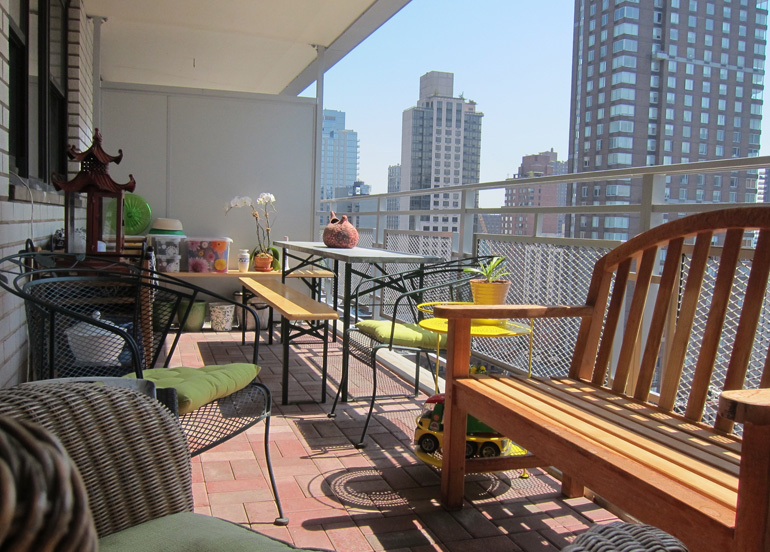Gotham Diary:
Curbed
5 June 2013
It was on the first leg of my round of errands that I realized that I should have to go home before setting out on the second. I had forgotten the key, the key to the storage unit, located a few blocks east of the well-known lamp emporium on Lexington Avenue in the 60s. I was, therefore, lugging my laptop for nothing. My laptop is perfect for someone who travels from one room to another; carried beyond the apartment’s threshold, it puts on a lot of weight. I sighed but managed to curb genuine irritation. At least I wouldn’t be carrying the bulky lampshade frame that I had brought in for recovering, but which was going, it turned out, to be thrown away — it was somewhat crude, said the salesman, and in need of repairs that would cost almost as much as a new frame. I was very happy about the apple-green silk-wool twill that we had found for the new lampshade, which will be the first thing that anybody coming into the apartment sees. Lampshades usually are the first things that you see: they surround sources of light. But they go unnoticed, designed to complement a room without attracting attention to themselves. I don’t expect the new lampshade to attract a lot of conscious attention, but I know that it will put people on notice that they’re entering the kind of place that greets you with a shot of apple green.
When my transactions were complete, I walked over to Third Avenue and caught a taxi. Although it was a beautiful day, traffic was terrible. I couldn’t decide what to do next, but when I got to the apartment, I stayed there just long enough to wash my hands and do one or two things. I stuffed some shirts into my consolidated tote bag and headed down and out. In the taxi, I realized that I’d forgotten to stop in at the dry cleaner’s on my way out and was still carrying the shirts. It was that kind of day. But I did have the key.
By now, it was nearly two, and lunch was way overdue. I thought twice about having my usual burger, with accompanying black-and-tans, at the Baker Street Pub, before trying to get something done at the storage unit, but I decided to risk it. In the event, it didn’t hurt, because I never could bring up the library database on the laptop. I thought that I had fixed whatever it was that doomed my first attempt, a few weeks before, but I was wrong. It would take an hour of help from Jason, back at the apartment, for me to figure out how to make Readerware work “offsite” — Jason’s word for anywhere not connected to the wireless network at home, through which a number of data banks are based (not just backed up) on a NAS server. Jason, paying a visit via TeamViewer, reminded me, ahem, that Readerware is designed for use on one, presumably stationary, computer. Jason is forever reminding me, graciously as you please, that I am living in the Flinstone era. That’s okay, because he usually has a workaround.
Before the session with Jason, as I was coming home from the storage unit, I walked right past the dry cleaner’s again. It really must have been a beautiful day, because I was still able to curb irritation. I cleaned up, changed into house clothes, and took the shirts down to the dry cleaner’s. Not having learned to do one thing at a time, I also took the cards that we use in the laundry room; there’s a device in the lobby that enables you to put more money on them. But I forgot that they were in my pocket when the dry cleaner produced a cumbersome bedspread for me to carry home. It was the kind of day when some little thing goes wrong at every turn, but to no effect. When irritation is curbed. A very rare kind of day. Perhaps not a kind of day at all, but unique.
After the session with Jason, I sat outside in the lovely evening light and read Albert Hirschman on interests and linkages. Then Kathleen came home from Washington, and we had a pizza.
***
Have you read Walter Kirn’s piece about his friendship with Clark Rockefeller, in the current (Fiction) issue of The New Yorker? As is well-known now, Clark Rockefeller was a Bavarian, and not a Rockefeller at all. Was he a con man? Hard to say; he was so much more, and so peculiar as well. He was certainly a murderer — or at any rate a jury had no reasonable doubt that he was. Kirn admits to being dazzled by the friendliness of a man who appeared to belong to the ultimate inside establishment. His memoir of an uneasy undergraduate career at Princeton, alluded to here, prepared me for the story that he had to tell about “Rockefeller,” whose real name was Christian Karl Gerhartsreiter. Kirn is careful to demonstrate that the point of such stories is that they are never about the showman; they’re about you, about what makes you fall for such a guy.
As an English major at Princeton, I’d learned the phrase “suspension of disbelief,” but with Clark you contributed belief, wiring it from your personal account into the joint account that you held with him. He showed you a hollow tree, you added the bees. He gave you the phone number of the President; you added the voice that would greet you if you dialled it, and the faces of the Secret Service agents who would show up at your home a few days later. He gave you an envelope with a check inside; you filled in the amount.

